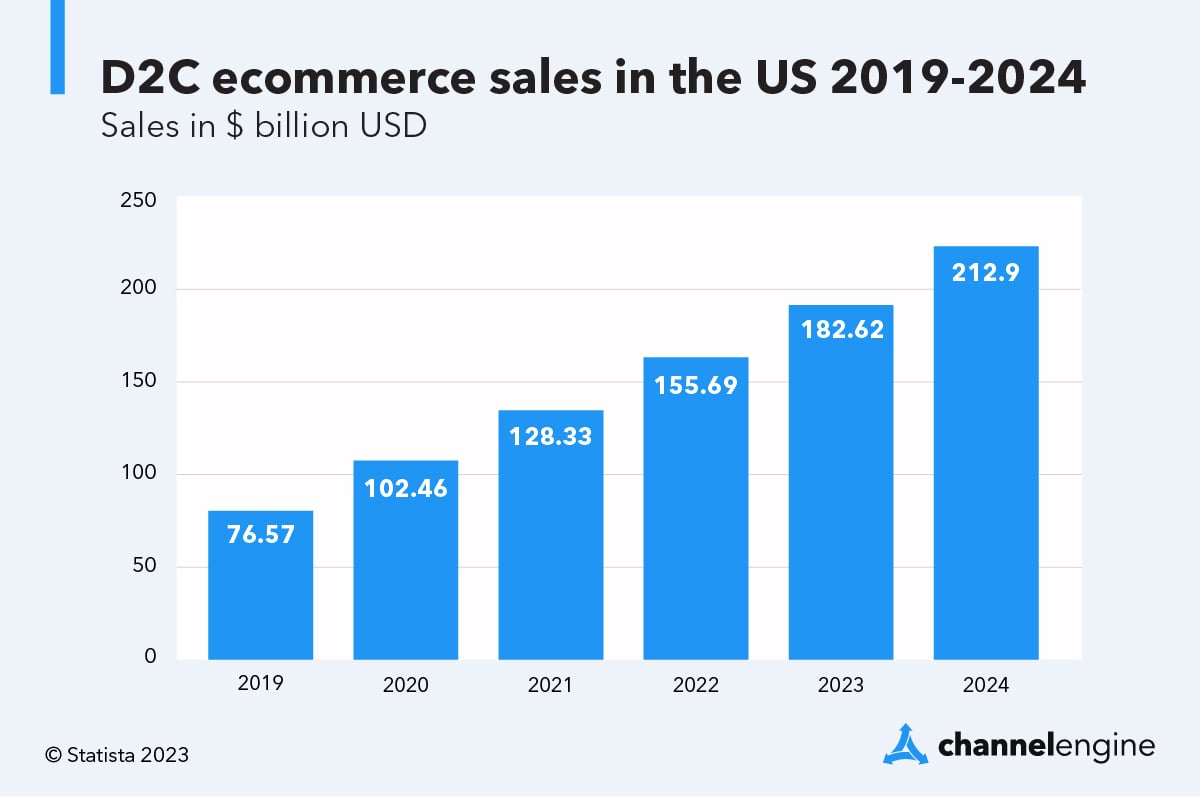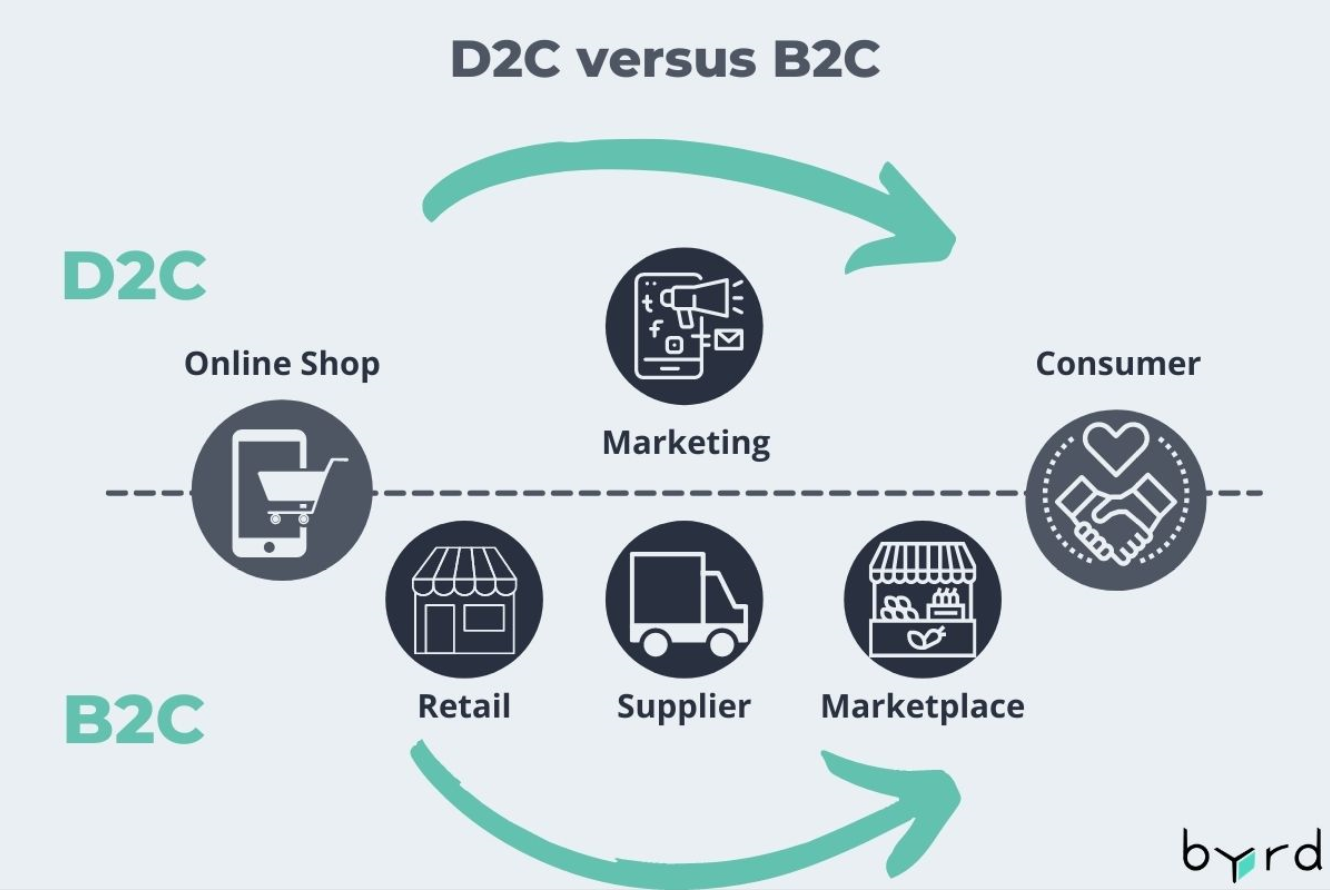Checking out the Potential of D2C Ecommerce: A Comprehensive Guide for Companies
The D2C ecommerce model offers a substantial change in just how brands engage with consumers. It allows firms to bypass typical retail networks, promoting much deeper links and possibly boosted revenue margins. This technique is not without its complexities. Recognizing the subtleties of D2C ecommerce is vital for brand names intending to thrive. What approaches can they embrace to navigate this advancing landscape effectively? The solutions may redefine their service approaches.
Recognizing the D2C Ecommerce Model

Secret Perks of D2C Ecommerce for Brands
The D2C ecommerce version provides brands considerable benefits, especially pertaining to increased revenue margins. By eliminating intermediaries, companies can retain a larger share of sales earnings. In addition, this direct connection with clients promotes boosted brand name commitment, motivating repeat acquisitions and long-term involvement.
Increased Profit Margins

Enhanced Brand Name Loyalty
Building on the economic advantages of D2C ecommerce, boosted brand name commitment becomes another important advantage for companies engaging directly with customers. By establishing a direct link, brand names can cultivate much deeper connections with their clients, obtaining understandings into habits and preferences. This direct communication enables more customized advertising approaches, which resonate highly with customers. Additionally, brand names have the possibility to control their messaging and consumer experience, strengthening brand name values and developing count on. When clients feel an individual connection, they are most likely to return, advocate for the brand name, and take part in community engagement. Ultimately, enhanced brand name commitment not just drives repeat purchases however also grows a passionate client base, more solidifying a brand's position in the market.
Obstacles Faced by D2C Brands
D2C brand names encounter numerous considerable obstacles that can influence their success. Supply monitoring concerns can bring about stock lacks or excess, complicating operations and consumer satisfaction. In addition, advertising and marketing budget constraints frequently limit the capacity to successfully involve and get to target market.
Inventory Monitoring Issues
Effective stock management provides a powerful challenge for several brands running in the direct-to-consumer (D2C) space. These brand names frequently face varying need, which can bring about overstock or stockouts, eventually affecting consumer satisfaction and profits. Additionally, the lack of sophisticated inventory radar can result in disparities between actual supply degrees and reported data, complicating order fulfillment. The diverse variety of products D2C brand names typically use additionally makes complex inventory monitoring, as variations in colors, styles, and dimensions require even more meticulous oversight. Moreover, lots of D2C businesses might have problem with limited warehousing abilities, bring about ineffective use space and sources. Subsequently, reliable supply monitoring remains a crucial hurdle for D2C brands going for lasting development and operational performance.
Marketing Budget Plan Constraints
Steering advertising budget plan restraints is a significant challenge for lots of direct-to-consumer (D2C) brand names. Limited funds typically limit these firms' capability to buy all-encompassing marketing approaches, causing reduced presence in an open market. D2C brand names regularly grapple with the requirement to make best use of roi (ROI) while targeting certain audiences efficiently. This obstacle is intensified by increasing costs in electronic marketing and the need to designate funds across several networks, including social networks, internet search engine, and email advertising. Consequently, many D2C brand names have to introduce cost-efficient advertising and marketing services, leveraging natural development methods and influencer partnerships. Inevitably, effectively maneuvering these budget plan constraints is essential for sustaining development and accomplishing long-term earnings in the evolving ecommerce landscape.
Approaches for Developing an Effective D2C Ecommerce Company
As customers progressively look for straight links with brand names, establishing a successful D2C ecommerce service calls for a tactical strategy that focuses on consumer interaction and trust. One efficient technique is to develop engaging brand narratives that reverberate with target market, fostering psychological links. Utilizing social networks platforms can enhance presence and facilitate two-way communication, enabling brands to engage directly with customers.Moreover, personalized experiences through tailored marketing initiatives can greatly boost customer retention and commitment. Applying commitment programs and offering exclusive bargains can additionally incentivize repeat purchases.Streamlining the buying process is necessary, making certain an easy to use interface that read more enhances the purchasing experience. Furthermore, transparent communication relating to delivery and returns develops count on and encourages customer confidence.Finally, proactively seeking customer responses and reacting to it demonstrates a commitment to renovation and consumer contentment, crucial components in the competitive D2C landscape.
Leveraging Technology for Improved Customer Experience
In today's affordable D2C ecommerce landscape, innovation plays a pivotal role fit customer experiences. Companies increasingly make use of sophisticated devices such as expert system, chatbots, and customized algorithms to improve communications and enhance the shopping process. By incorporating these innovations, brand names can provide tailored item suggestions based upon individual preferences and buying actions, promoting an extra engaging experience.Moreover, responsive internet site designs and mobile applications assure that customers can access solutions seamlessly across different tools. Boosted repayment services, including digital pocketbooks and one-click checkouts, additionally streamline purchases, making it simpler for consumers to make purchases.Data analytics additionally makes it possible for organizations to collect insights into consumer behavior, permitting constant enhancement of services and offerings. In general, leveraging innovation not just boosts consumer complete satisfaction yet also grows commitment, inevitably driving lasting success in the D2C ecommerce industry.
Advertising Tactics to Drive D2C Sales
How can brands effectively record the attention of consumers in a saturated market? To flourish in the direct-to-consumer (D2C) landscape, brands must employ targeted advertising techniques. Making use of social media sites systems, brands can engage customers with interactive content, influencer partnerships, and user-generated posts. Personalized e-mail campaigns can additionally promote a sense of link, offering customized promos based upon customer actions and preferences.Moreover, storytelling plays a crucial role in setting apart a brand name's narrative, making it remarkable and relatable. Brand names ought to purchase search engine optimization (SEO) to boost visibility, guaranteeing their products are easily visible online. Additionally, leveraging information analytics permits companies to fine-tune their advertising approaches and recognize customer patterns better. Ultimately, a multi-channel strategy that combines creativity with data-driven insights can substantially increase D2C sales, permitting brands to stand apart in a congested market.
Future Trends in D2C Ecommerce
With the quick evolution of innovation and consumer preferences, the future of D2C ecommerce is poised for considerable transformation. Arising patterns suggest a change in the direction of hyper-personalization, where brand names take advantage of information analytics to tailor offerings to private customer needs. This modification enhances customer experiences, promoting commitment and engagement.Moreover, sustainability is coming to be a crucial factor, with consumers progressively preferring brand names that focus on environmentally friendly techniques - D2C Ecommerce Agency. Companies are anticipated to take on transparent supply chains and sustainable materials to fulfill this demand.The integration of man-made knowledge and boosted fact will in addition reinvent the buying experience, enabling consumers to envision products in their environments prior to acquisition. In enhancement, social business is expected to grow, as systems like Instagram and TikTok facilitate seamless buying experiences directly within social media.These patterns collectively signify a vibrant future for D2C ecommerce, emphasizing customer-centric approaches and cutting-edge modern technologies that redefine customer interactions
Frequently Asked Questions
What Industries Advantage The Majority Of From D2C Ecommerce?
The existing concern highlights markets that flourish via direct-to-consumer (D2C) ecommerce. Remarkably, fashion, beauty, electronic devices, and food industries take advantage of D2C designs to enhance brand name commitment, improve client connections, and enhance revenue margins effectively.
Just How Do Shipping Expenses Affect D2C Rates Strategies?
Shipping expenses greatly affect D2C pricing approaches. Organizations must stabilize these expenditures with competitive pricing, taking into consideration customer expectations and profit margins. Efficient management of shipping can enhance customer fulfillment and drive sales in direct-to-consumer models.
What Payment Options Should D2C Services Deal?
D2C businesses must use varied settlement options, including credit/debit cards, digital wallets, and buy now, pay later solutions. This selection boosts consumer benefit, boosts conversion rates, and deals with various customer choices in the on-line purchasing landscape.
Just How Can D2C Brands Handle Client Returns Efficiently?
D2C brands can manage consumer returns efficiently by implementing user-friendly return plans, supplying prepaid delivery labels, and guaranteeing prompt refunds (D2C Ecommerce Agency). Clear communication and structured processes boost customer complete satisfaction and encourage repeat company
What Lawful Factors To Consider Exist for D2C Ecommerce Workflow?
Lawful considerations for D2C ecommerce procedures consist of compliance with customer security laws, information privacy policies, copyright legal rights, and taxes demands. Brands must navigate these intricacies to avoid lawful risks and guarantee smooth operations. By removing intermediaries, D2C brands can provide competitive rates and promote a more intimate connection with their customers.The D2C model is characterized by its reliance on electronic platforms, enabling brand names to use social media, on the internet markets, and their own internet sites to involve with consumers directly. D2C ecommerce facilitates the collection of important consumer data, allowing brands to customize their offerings and marketing techniques properly, ultimately driving sales and increasing margins. Additionally, brands have the chance to control their messaging and customer experience, reinforcing brand name values and building count on. As customers progressively look for straight links with brand names, establishing a successful D2C ecommerce service needs a critical strategy that prioritizes customer engagement and trust. D2C brands can deal with consumer returns effectively by implementing user-friendly return policies, providing pre-paid delivery tags, and making certain prompt reimbursements.
Comments on “How a D2C Ecommerce Agency Can Help You Cut Out the Middleman and Boost Profits”